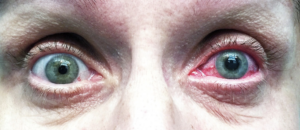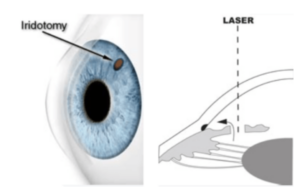Angle-closure Glaucoma
What is Angle-closure glaucoma (ACG)
Angle-closure glaucoma (ACG) is a sight-threatening eye condition that arises from the obstruction of the drainage angle within the eye, leading to a rapid increase in intraocular pressure (IOP). Unlike open-angle glaucoma, angle-closure glaucoma manifests with sudden and severe symptoms, making timely intervention crucial. In this article, we will explore the characteristics, risk factors, and urgency associated with angle-closure glaucoma.
Characteristics of Angle-Closure Glaucoma
- Mechanism of Obstruction
ACG occurs when the drainage angle between the iris and cornea becomes blocked, preventing the normal outflow of aqueous humor, the fluid that maintains intraocular pressure. This blockage may be caused by the forward displacement of the iris, leading to a sudden and complete closure of the drainage angle. - Rapid Increase in Intraocular Pressure (IOP)
Unlike open-angle glaucoma, where the increase in intraocular pressure is gradual, angle-closure glaucoma results in a rapid elevation of IOP. This sudden rise is a hallmark of ACG and can lead to intense eye pain and other alarming symptoms. - Symptoms

ACG typically presents with acute symptoms, including severe eye pain, headache, blurred vision, halos around lights, nausea, and vomiting. The intensity and sudden onset of these symptoms distinguish ACG from other eye conditions. - Ophthalmic Emergency
Angle-closure glaucoma is considered a medical emergency due to its rapid progression and potential for irreversible vision loss. Immediate intervention is crucial to alleviate intraocular pressure and prevent optic nerve damage. - Red Eye and Corneal Edema

The increased pressure in the eye can cause redness, and corneal edema (swelling) may occur, leading to a hazy appearance of the cornea. These signs further emphasize the urgency of seeking medical attention.
Risk Factors for Angle-Closure Glaucoma
- Age
Older individuals are more susceptible to angle-closure glaucoma, especially after the age of 40. The risk increases with advancing age, and postmenopausal women may face a higher likelihood. - Hyperopia (Longsightedness)
Individuals with hyperopia, particularly those with a high degree of farsightedness, have an increased risk of developing angle-closure glaucoma. The shape of the eye in hyperopic individuals may contribute to the narrowing of the drainage angle. - Race and Ethnicity
Certain ethnic groups, including individuals of Asian descent, have a higher prevalence of angle-closure glaucoma. This predisposition is often associated with anatomical variations in the eye structure. - Family History
A family history of angle-closure glaucoma increases the risk for developing the condition. Genetic factors may play a role in the anatomical characteristics that contribute to angle closure.
Treatment and Management
- Emergency Medical Attention
Immediate medical intervention is essential for individuals experiencing symptoms of angle-closure glaucoma. The goal is to reduce intraocular pressure promptly and prevent further damage to the optic nerve. - Laser Peripheral Iridotomy (LPI)

LPI is a laser procedure that creates a small hole in the peripheral iris, allowing the aqueous humor to flow more freely and relieve the blockage at the drainage angle. This procedure is often performed urgently to address the underlying cause. - Medications
Medications, such as oral carbonic anhydrase inhibitors and topical miotics, may be prescribed to lower intraocular pressure and manage symptoms. - Surgical Interventions
In some cases, surgical procedures, such as laser iridoplasty or iridectomy, may be performed to address the anatomical issues contributing to angle closure.
Prevention
Angle-closure glaucoma demands swift and decisive action due to its sudden onset and potential for rapid vision loss. Recognizing the symptoms, understanding the risk factors, and seeking immediate medical attention are crucial for a favorable outcome. Regular eye examinations, especially for individuals at higher risk, play a preventive role in identifying anatomical predispositions and allowing for proactive management. Remember, when it comes to angle-closure glaucoma, time is of the essence, and prompt intervention can make a significant difference in preserving vision and preventing long-term complications.
